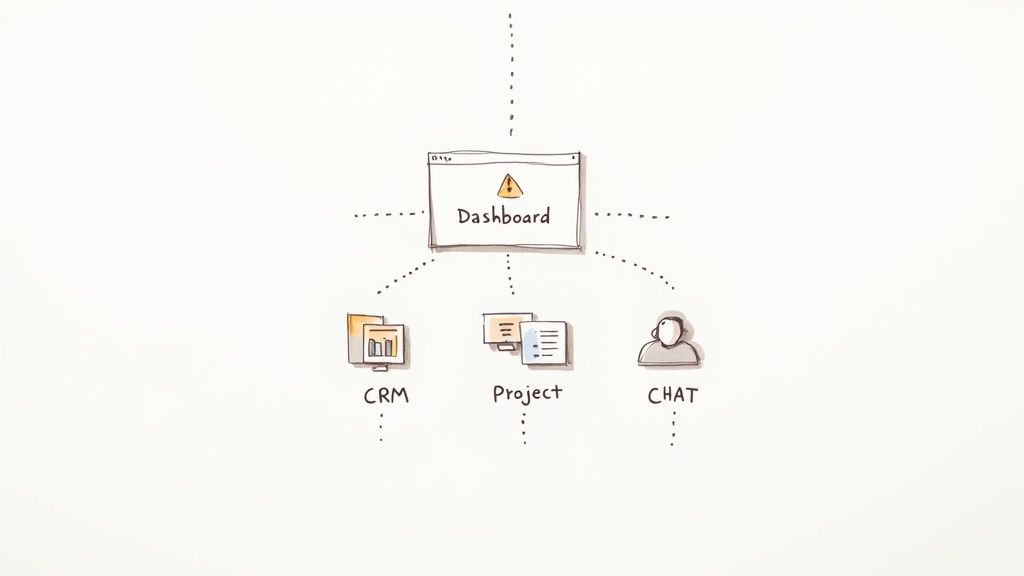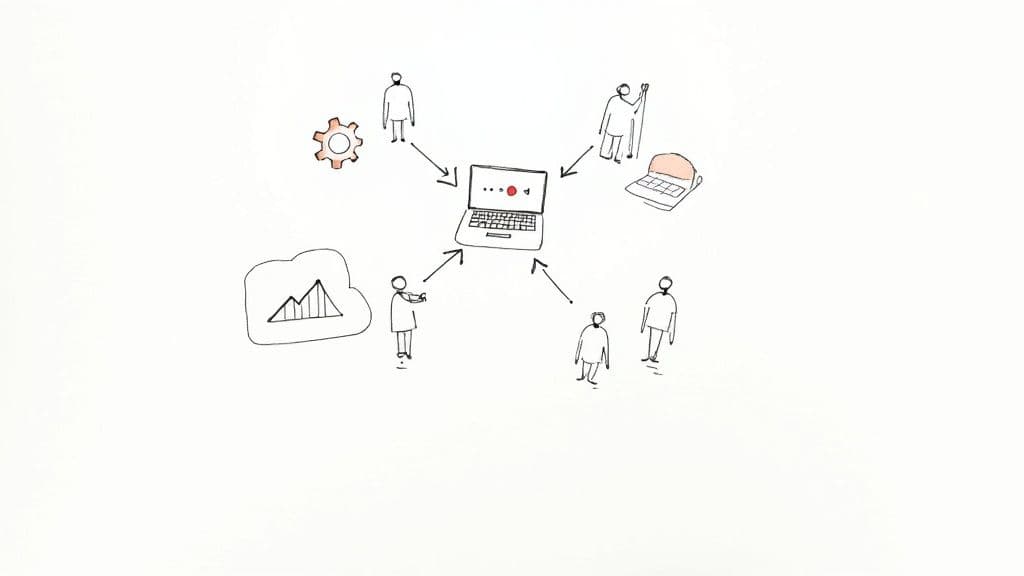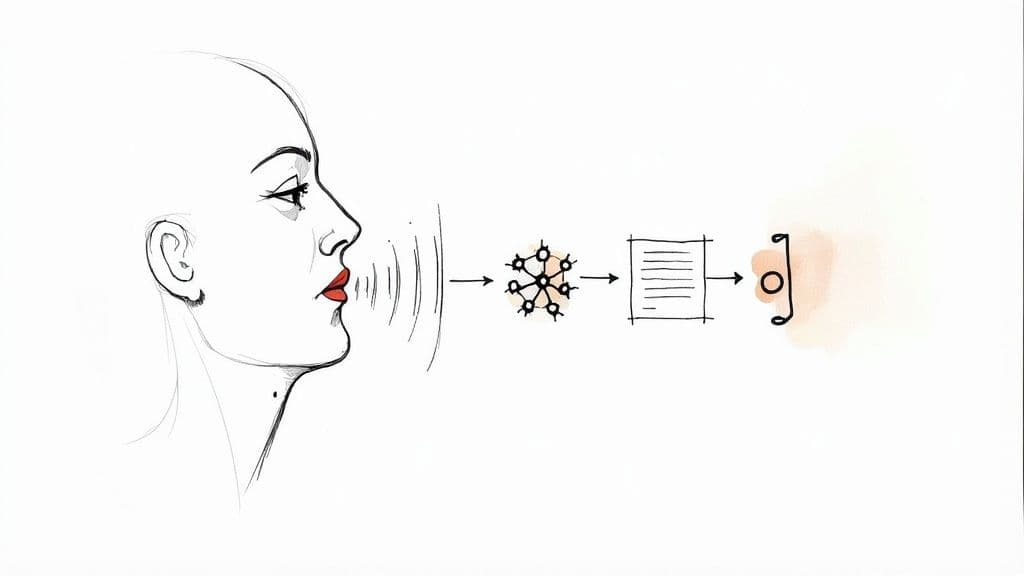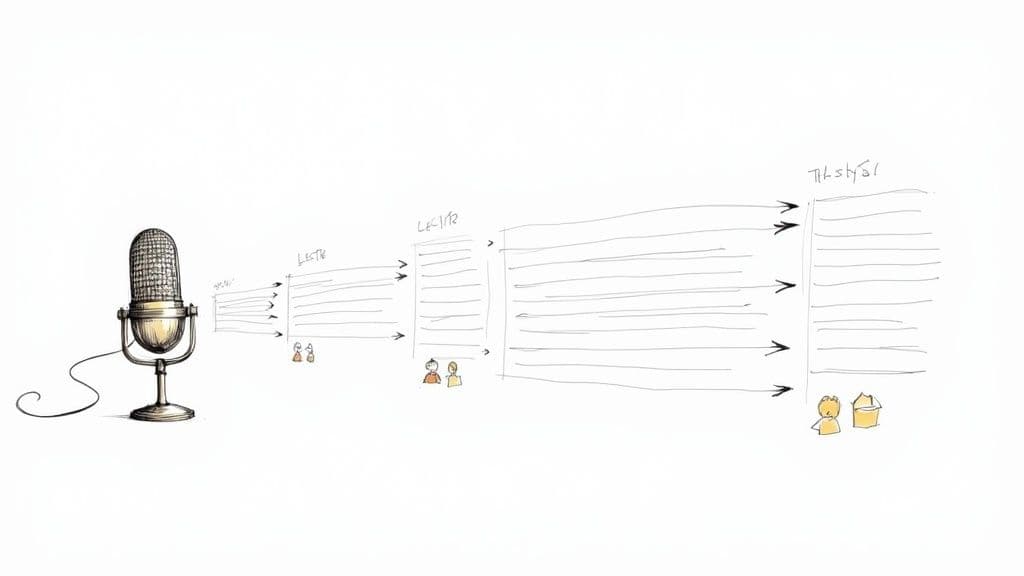Improving workflow efficiency is about systematically identifying and eliminating the friction points in your daily operations. It’s a strategic blend of process mapping, smart automation, and integrating the right technology to get tasks done faster, cheaper, and with fewer errors. The ultimate goal of improving workflow efficiency is simple: to stop working harder and start working smarter. This guide provides actionable steps for achieving a more streamlined and productive operational flow.
Why Improving Workflow Efficiency is Crucial
Clunky, inefficient workflows are the silent killers of productivity. They manifest as missed deadlines, burned-out teams, and stalled growth, quietly bleeding your company of resources and morale. Many teams accept this operational drag as "the way things are done," failing to see the massive hidden cost of wasted time, duplicated work, and endless communication loops. This guide offers a hands-on framework for improving workflow efficiency and reclaiming that lost potential.
The core problem is that broken processes force talented people to waste time on low-value, repetitive tasks instead of the strategic, creative work they were hired for. Consider the hours spent manually copying data, chasing approvals, or fixing errors from inconsistent procedures. These small hiccups quickly add up, creating significant bottlenecks that choke your company's ability to scale. A focus on improving workflow efficiency directly addresses these issues.
The Real Cost of Inefficiency
The damage from poor workflow management extends beyond frustration; it directly impacts your bottom line and competitive edge. When your workflows are clogged, you experience:
- Higher Operational Costs: More time spent on a task means higher labor costs—time that could be invested in revenue-generating activities.
- Lower Employee Morale: Constantly fighting frustrating processes leads to disengagement and high employee turnover.
- Slower Growth: Inability to handle increased volume efficiently means your business cannot scale. You hit a growth ceiling, fast.
The good news is that improving workflow efficiency provides a significant competitive advantage. Workflow automation alone can reduce repetitive tasks by 60-95%, which translates to saving up to 77% of the time spent on routine activities.
This isn't just about new software; it's about fostering a culture of continuous improvement. The data supports this: 75% of businesses view workflow automation as a key competitive advantage, and 70% of owners believe it's essential for scaling. For a deeper look, you can explore more AI workflow statistics. By critically examining your current processes, you can begin the powerful journey of improving workflow efficiency for a more productive, streamlined operation.
How to Map Your Workflow and Find Hidden Bottlenecks
You can't fix what you can't see. Before you can start improving workflow efficiency, you need an honest, unfiltered view of your current processes. This requires creating a visual map that exposes every step, handoff, and decision point, moving beyond guesswork to concrete analysis.
Most teams operate on autopilot, sticking to familiar methods. This is where tiny friction points hide, adding up to create massive delays and resource drains. The purpose of workflow mapping is to bring these hidden issues into the light. It’s the difference between a vague sense that "things are slow" and pinpointing the exact stage where a project stalls for three days awaiting approval. This clarity is the first step in improving workflow efficiency.
This infographic illustrates how small snags can snowball, leading to burnout and halting business growth.

As shown, the path from inefficiency to growth is blocked by friction that wears down your team. Identifying and addressing these bottlenecks early is essential for improving workflow efficiency.
Uncovering the Root Causes of Delays
Spotting a delay is not enough; you must understand its cause. A couple of practical techniques can help you dig deeper than surface-level symptoms to find the real problem.
Process Shadowing: Simply observe a team member as they complete a specific workflow from start to finish. You’ll see where they get stuck, which tools are cumbersome, and what manual workarounds they've created. This provides invaluable insights that surveys or meetings can't capture.
The '5 Whys' Method: When you identify a problem, repeatedly ask "Why?" For instance, if "reports are always late," the first 'Why' might be "because the data isn't ready." By the fifth 'Why,' you might uncover the root cause: an unclear data request process at the beginning of the month.
This table outlines common issues and their underlying causes, providing a starting point for your analysis.
Common Workflow Bottlenecks and Their Root Causes
| Symptom (The Problem You See) | Common Root Cause | Potential First Step to Fix |
|---|---|---|
| Projects stall waiting for approvals | Unclear decision-making authority or overloaded managers. | Create a simple RACI chart or delegate approval power for smaller tasks. |
| Repetitive manual data entry | Lack of tool integration or awareness of automation features. | Explore using a tool like Zapier or a built-in webhook to connect apps. |
| Constant back-and-forth for clarification | Vague initial briefs or incomplete project requirements. | Develop a standardized project kickoff template that must be completed. |
| Missed deadlines on team projects | Poor visibility into task dependencies and individual workloads. | Implement a shared project management board (e.g., Trello, Asana). |
Think of these as clues. Once you've identified the real bottlenecks, you're in a much better position to actually improve team productivity because you're treating the disease, not just the symptoms.
Visualizing Your Process and Prioritizing Fixes
After gathering information, draw it out. Use a whiteboard or digital tool to map every step from trigger to output. This visualization makes it obvious where tasks are piling up or communication is failing. With your bottlenecks clearly identified, you can analyze and prioritize them.
Don't try to fix everything at once. Focus on low-hanging fruit. A small tweak saving each team member 15 minutes a day provides a more immediate and powerful return than a massive, six-month overhaul. This is a key strategy for improving workflow efficiency.
By mapping your workflow, you create a data-driven starting point for real improvement. You replace assumptions with facts, allowing you to make targeted changes that produce measurable results.
Give Your Team a Boost with Strategic Automation
Automation isn't about replacing your team; it's about upgrading their capabilities. The goal is to delegate repetitive, mundane tasks to technology so your people can focus on work that requires human intellect: strategy, creativity, and problem-solving. This is a cornerstone of improving workflow efficiency.
Many teams are stuck on a hamster wheel of manual work, like endless data entry or generating the same weekly reports. These tasks are not only tedious but are also prime sources of errors and bottlenecks. The first step to breaking this cycle is identifying these repetitive loops and implementing smart automation. If you're new to the concept, understanding What is Workflow Automation? is an excellent starting point.
Pinpointing the Best Processes to Automate First
The key to successfully improving workflow efficiency with automation is to start small and aim for big wins. You don't need to automate your entire business overnight. Look for tasks that are frequent, rule-based, and prone to human error.
Classic starting points that consistently deliver results include:
- Data Entry and Transfer: Copying new lead details from a form into your CRM is a perfect candidate.
- Report Generation: Any report pulling the same data from the same sources on a regular schedule.
- Client Onboarding: Sending welcome emails, creating project folders, and assigning initial tasks for new clients.
- Notifications and Alerts: Manually reminding team members about deadlines or follow-ups.
For example, a tool like MeowTxt automates the painfully manual process of transcribing audio, a clear win for improving workflow efficiency.
This kind of simple, drag-and-drop interface demonstrates how easily hours of work can be eliminated with the right tool.
Turning Conversations into Searchable Gold
Here’s a powerful, real-world example of improving workflow efficiency: meeting notes. Meetings contain crucial information, but manually transcribing notes, identifying action items, and sharing summaries is a massive time-drain.
Cloud transcription services like MeowTxt completely automate this process. You upload a recording from a sales call or team sync, and it generates a precise, time-stamped transcript. Instantly, that unstructured conversation becomes a searchable, valuable asset. For teams using Microsoft Teams, there are specific guides on setting up Microsoft Teams transcription to create a perfect record of every important discussion.
This is about more than saving time. It builds a reliable knowledge base, establishes accountability for action items, and makes key information accessible to anyone who missed the meeting—without requiring them to watch an hour-long recording.
The data confirms this approach to improving workflow efficiency. Automation has improved jobs for 90% of knowledge workers, and 66% report a productivity boost. It also reduces data capture errors by 37% and improves data accuracy by a staggering 88%. Furthermore, 32% of companies see a major drop in human error after adopting these tools.
Building Your Automation Toolkit
Choosing the right tools is critical for improving workflow efficiency. The goal is to create a smart ecosystem where your apps communicate, reducing manual busywork for your team.
Here’s how to approach your options:
- Task-Specific Tools: These are tools designed for a single job, like MeowTxt for transcription or Calendly for scheduling. They are simple to implement and solve a specific pain point effectively.
- Integration Platforms: Services like Zapier or Make act as the glue connecting the apps you already use. They let you build simple "if this, then that" automations without writing any code. For example: "If a new file is added to a Google Drive folder, automatically transcribe it with MeowTxt and post a link in Slack."
By thoughtfully connecting these tools, you create a system that not only does work for your team but actively supports them, reducing grind and boosting both capacity and morale.
Weave Your Tech Stack into a Single Source of Truth
Having a dozen powerful apps is great, but if they don't communicate, you've created a dozen digital islands. True workflow efficiency isn't about having the fanciest tools; it's about making them work together, allowing data to flow freely so your team can stop the endless copy-pasting.
When tools are disconnected, your team becomes the human bridge, manually shuffling data from a CRM to a project manager and then to a communication channel. This is slow and a recipe for costly mistakes that can halt projects. Improving workflow efficiency requires building a single source of truth—a central nervous system where every app is synchronized and data is consistent everywhere.

Connecting Your Tools Without Writing a Line of Code
The good news is you don’t need to be a developer to make your apps communicate. This is where integration platforms like Zapier or Make are invaluable. They act as universal translators for your software, the digital glue holding your entire operation together.
These platforms operate on simple "if this, then that" logic. For example, you could create a rule: "When a new lead in our CRM is tagged 'Qualified,' automatically create a new project in Asana and notify the #sales channel in Slack." A clunky, manual process becomes an instant, error-free automated workflow, a clear win for improving workflow efficiency.
Real-World Scenarios for a Truly Unified Workplace
Let's see how integrating tools plays out across different business functions, which is where the real magic of improving workflow efficiency happens.
From Sales to Project Management: A signed contract in PandaDoc can trigger a chain reaction: create a new client folder in Google Drive, set up a project board in Trello, and launch a welcome email sequence in Mailchimp. Onboarding delays and inconsistent setups become a thing of the past.
Marketing and Content Creation: A recorded webinar is a content goldmine, but manually processing it is a chore. An automated workflow can handle it: the video uploads to a specific folder, which triggers MeowTxt to transcribe the audio. To see how powerful this is, check out this audio-to-text conversion guide.
Customer Support: A high-priority ticket in Zendesk doesn't just sit there. It can automatically create an urgent task for a developer in Jira and send a direct message to the product manager, drastically reducing resolution times.
By connecting your tools, you are not just automating tasks; you are building an intelligent, unified digital workplace. The focus shifts from managing software to executing high-value work, supported by a system that ensures data is always accurate and accessible. This is the foundation for improving workflow efficiency and scaling operations effectively.
How to Measure Your Workflow Efficiency Gains
Making changes to your workflow without measuring the outcome is like shooting arrows in the dark. You feel busy, but you have no idea if you’re hitting the target. To truly understand the impact of your new processes, you must move from gut feelings to hard data. This is where Key Performance Indicators (KPIs) become your best friend.
Setting the right KPIs is the only way to prove that your efforts in improving workflow efficiency are paying off. Vague goals like "be more productive" are useless. You need specific, measurable metrics that directly reflect the changes you’ve made. This data not only shows progress but also builds a rock-solid business case for future optimization investments.
Choosing the Right KPIs for Your Team
Not all metrics are created equal. The KPIs for a marketing team will differ from those for an operations team. The secret is to choose indicators that directly tie back to the specific bottlenecks you've addressed.
Before you do anything else, establish a baseline. You must measure performance before making changes. This is non-negotiable. It's the only way to get a clear before-and-after picture that demonstrates real improvement in your workflow efficiency.
Here are some powerful, actionable KPIs that work wonders:
- Cycle Time: The total time from a task's start to its finish. For a content team, this could be the time from article idea to publication. A 25% reduction in cycle time means you're delivering value to customers that much faster.
- Task Throughput: This measures how many tasks your team completes in a set period. If your support team resolved 150 tickets last month and 200 this month with the same headcount, your throughput has significantly increased.
- Error Rate Reduction: This tracks the frequency of mistakes that require rework. A lower error rate in order fulfillment, for example, directly translates to happier customers and lower operational costs.
Turning Data into Actionable Insights
Tracking numbers isn't enough. The real magic happens when you analyze the data to understand what's working and what isn't. If cycle time is down but error rates are up, it’s a sign that your new process is fast but rushed. This is where you need qualitative feedback to understand the why behind the numbers. For a deeper dive, you can explore various qualitative data analysis techniques.
Your goal is not just to gather data but to use it to build a culture of continuous improvement. When your team sees tangible proof that their efforts are making a difference, they become motivated to find the next opportunity for improving workflow efficiency.
This focus on measurement is increasingly critical. The workflow automation market is projected to hit $78.26 billion by 2035. Companies that adapt early are already seeing cost savings of up to 30%, and future AI-driven processes could unlock trillions in economic value. You can find out more by exploring the latest workflow automation industry research.
By diligently measuring your workflow efficiency gains, you turn optimization from a one-off project into a sustainable, data-driven habit. And that's how you build a smarter, more resilient organization.
Got Questions About Improving Workflow Efficiency? We’ve Got Answers.
Even with the best plan, you're likely to encounter challenges when you start optimizing workflows. That's normal. This section answers common questions that arise during a workflow overhaul. Think of it as a quick-reference guide from someone who has been in the trenches.
Where Do I Even Begin? The Whole System Feels Broken.
This is a common feeling when the number of clunky processes seems paralyzing. The best advice for improving workflow efficiency from the start is: don't try to boil the ocean.
Look for a process that is high-frequency, low-risk, and a major source of team frustration. Good candidates include:
- Compiling mind-numbing weekly reports.
- Manually copy-pasting data between two essential systems.
- The paperwork for onboarding a new client.
By picking one small but consistently painful process, you achieve a quick, visible win. It’s a low-stakes way to learn process mapping and automation, and more importantly, it builds momentum for tackling bigger, more critical workflows.
How Can I Get My Team to Actually Use the New Workflows?
The most brilliant workflow is worthless if no one uses it. The secret to adoption isn't a mandate; it's involvement. Involve your team in the discovery process from day one. Ask them: "What is the most annoying, time-wasting part of your day?" When you introduce a new tool or process, frame it as the direct solution to the problems they identified.
Always focus on the "what's in it for me." Show them how these changes will eliminate tedious tasks, freeing them up for more interesting, high-impact work. This is key to getting buy-in for improving workflow efficiency.
Don’t just provide a new tool and walk away. Offer solid training, accessible guides (like short videos or checklists), and an open channel for feedback. Celebrate early wins publicly. Nothing convinces people faster than seeing proof that the new way is genuinely better.
What Are the Biggest Mistakes People Make When Improving Workflow Efficiency?
One mistake stands out: automating a broken process. Automation is a massive amplifier. If you have an efficient workflow, it makes it lightning-fast. But if your workflow is flawed, automation helps you create disasters at an incredible speed. Always map, simplify, and fix a process manually before automating it.
Another common pitfall is buying shiny new tech without a clear problem to solve, leading to expensive "shelfware." Finally, don't forget to measure. Failing to benchmark your starting point makes it impossible to prove the changes worked. Always track your key metrics before and after implementing a change to demonstrate a real return on your efforts in improving workflow efficiency.
Ready to slash manual transcription from your workflow for good? With MeowTxt, you can instantly turn your meetings, interviews, and videos into accurate, searchable text. Get your first 15 minutes free and see the difference it makes.



